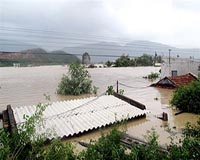| . |  |
. |
Bonn, Germany (SPX) Oct 21, 2010 The German Aerospace Center has become a member of the International Charter 'Space and Major Disasters'. At an event in Paris to celebrate the tenth anniversary of its founding, Johann-Dietrich Worner, Chairman of the DLR Executive Board, signed the charter, marking DLR's accession. With this signing, DLR has become the 11th space agency to pledge its expertise and resources, particularly those associated with global monitoring, to address natural disasters and major accidents.
DLR can make important contributions With its TerraSAR-X synthetic aperture radar satellite, Germany has a highly capable Earth observation system, which is able to provide valuable mapping data during natural disasters and accidents. "We are convinced that TerraSAR-X will make an important contribution towards the aims and objectives of the charter," said Prof. Worner, addressing representatives of other signatories to the charter. In the first instance, the core contribution DLR can make is through the radar imaging data provided by its TerraSAR-X satellite. "TerraSAR-X supplies detailed images very rapidly and is able to acquire those radar images irrespective of cloud cover or time of day. It is therefore very useful for incidents such as severe flooding," explained Stefan Voigt, Coordinator of the DLR Center for Satellite Based Crisis Information (Zentrum fur Satellitengestutzte Kriseninformation; ZKI), speaking at a meeting held during the event.
A great deal of experience in Germany The DLR Space Agency has also promoted the development of technical capabilities in this sector, under the auspices of the 'DeSecure' project. In addition, the German Federal Government, through its Ministry of Economics and Technology (Bundesministerium fur Wirtschaft und Technologie; BMWi), supports the Platform for Space-based Information for Disaster Management and Emergency Response programme (UN-SPIDER) operated by the United Nations. All these activities share a common objective, namely the improvement of the worldwide availability and use of satellite information for emergency response and crisis resolution.
No newcomer to the charter
About the charter Participation is voluntary and is based on the principle that all members will incorporate their systems to the best of their abilities within the mechanism of the charter. At present, the charter has 10 full members, including the European Space Agency, ESA, the French space agency, CNES, the Canadian Space Agency, CSA, the Indian Space Research Organisation, ISRO, the Japan Aerospace Exploration Agency, JAXA, and two American organisations, the National Oceanic and Atmospheric Administration, NOAA, and the United States Geological Survey, USGS. Since it was founded, the charter has been invoked 280 times; meaning that it has been possible to quickly supply maps derived from satellite imagery. Examples include the flooding of the River Elbe in 2002, the tsunami in the Indian Ocean in 2004 and the earthquake in Haiti in 2010.
Share This Article With Planet Earth
Related Links DLR ZIK (Center for Satellite Based Crisis Information) GMES: Services and Applications For Emergency Response Bringing Order To A World Of Disasters A world of storm and tempest When the Earth Quakes
 Red Cross appeals for one million dollars for Vietnam floods
Red Cross appeals for one million dollars for Vietnam floodsGeneva (AFP) Oct 18, 2010 The international Red Cross on Monday appealed for more than one million dollars in aid for victims of heavy flooding in Vietnam. "With large parts of central Vietnam still battling the after-effects of flooding, which has killed dozens of people and affected half a million residents, the International Federation of Red Cross and Red Crescent Societies is launching an emergency appeal for 1, ... read more |
|
| The content herein, unless otherwise known to be public domain, are Copyright 1995-2010 - SpaceDaily. AFP and UPI Wire Stories are copyright Agence France-Presse and United Press International. ESA Portal Reports are copyright European Space Agency. All NASA sourced material is public domain. Additional copyrights may apply in whole or part to other bona fide parties. Advertising does not imply endorsement,agreement or approval of any opinions, statements or information provided by SpaceDaily on any Web page published or hosted by SpaceDaily. Privacy Statement |